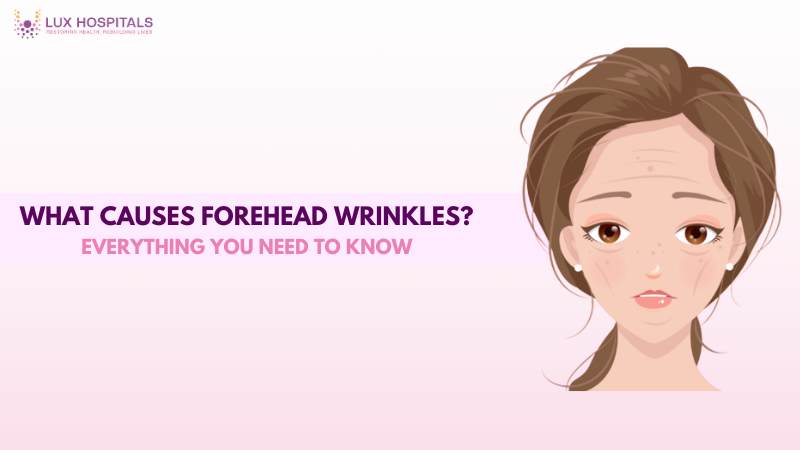What Causes Forehead Wrinkles? Everything You Need to Know

Wrinkles are a natural part of aging, but when they appear on your forehead, they can be one of the first noticeable signs. Forehead wrinkles, which include horizontal lines across the forehead and vertical lines between the brows, are often a cause of concern for many people. They can affect both men and women, and while they are generally harmless, they may cause some to feel self-conscious. But what exactly causes forehead wrinkles, and how can they be prevented or treated.
Key Causes of Forehead Wrinkles
Forehead wrinkles can form due to a variety of factors, some natural and others influenced by lifestyle choices or environmental conditions. From aging and sun exposure to stress and repetitive facial movements, these lines develop over time as a result of constant skin stress. Understanding the main causes can help you take steps to prevent or reduce them.
1. Ageing Process
One of the most common reasons behind the appearance of forehead wrinkles is the natural aging process. As we age, our skin undergoes various changes. The production of collagen and elastin the two proteins responsible for keeping skin firm and elastic begins to slow down. As a result, the skin becomes less resilient, and fine lines and wrinkles, including forehead wrinkles, start to form. Additionally, time causes the skin to lose moisture, making forehead wrinkles more noticeable
2. Repetitive Facial Movements
Repeated facial expressions are a major contributor to forehead wrinkles. The muscles in your forehead are regularly contracted when you frown, squint, or lift your eyebrows frequently. Over time, these muscle contractions can cause deep grooves in the skin, resulting in noticeable forehead wrinkles. People who express themselves a lot or tend to furrow their brows may notice forehead wrinkles appearing earlier than others.
3. Sun Exposure
Excessive sun exposure is one of the main environmental factors that speed up skin ageing. The sun’s ultraviolet (UV) radiation causes wrinkles in the skin’s collagen and elastin strands and early ageing. The forehead, one of the face’s most exposed parts, is especially susceptible to the sun’s rays. Additionally, sun damage impairs the skin’s capacity to repair and rejuvenate, eventually forming lines and wrinkles.
4. Genetics
Additionally, genetics is a significant factor in the formation of forehead wrinkles. If your parents or grandparents developed deep forehead lines as they aged, you may experience the same. Some individuals are more genetically predisposed to form wrinkles earlier, while others may have more youthful skin well into their later years. Apart from genetic susceptibility, elements like skin type (oily, dry, or combination) and skin tone can influence the visibility of forehead wrinkles.
5. Lifestyle Factors
Your lifestyle choices have a significant impact on your appearance and overall health. For instance, smoking is known to hasten the aging of the skin’s procedure. Cigarette smoke contains chemicals that harm collagen and elastin, causing premature wrinkles, particularly on the forehead. Similarly, dehydration and a poor diet can lead to parched skin that lacks the nutrients it needs to be firm and wrinkle-free.
6. Sleep Position
Believe it or not, how you sleep can influence the formation of forehead wrinkles. Sleeping on your side or face down can result in wrinkles and creases on your skin. With time, these creases may become permanent and result in forehead wrinkles. To prevent this, try sleeping on your back and using a satin or a silk pillowcase to lessen skin friction as you sleep.
7. Dehydration
Dehydrated skin is less plump and elastic and more prone to developing lines and wrinkles. When you don’t drink enough water, the skin becomes dry, which makes existing wrinkles, including forehead wrinkles, more noticeable. To keep your skin hydrated, drink plenty of water throughout the day and use moisturizing skincare products that help lock in moisture.
8. Stress and Tension
Chronic stress can lead to muscle tension, particularly in the forehead area. When stressed, you may unconsciously furrow your brow or clench your forehead muscles. This can lead to the formation of forehead wrinkles over time. Practicing stress management techniques, such as meditation or yoga, can help reduce forehead tension and prevent wrinkles caused by stress.
9. Pollution and Free Radicals
Environmental pollutants, like smog and smoke, can damage your skin by causing oxidative stress. Free radicals, highly reactive molecules generated by pollution, can break down collagen and elastin in the skin. This damage weakens the skin and makes it more prone to developing wrinkles, including on the forehead. Antioxidant-rich skincare products can reduce the appearance of forehead wrinkles and shield the face from the damaging effects of pollution.
10. Hormonal Changes
Our hormone levels change as we age, particularly during major life transitions like puberty, pregnancy, and menopause. These hormonal shifts may impact your skin’s suppleness and moisture content. During menopause, for instance, decreased estrogen production can lead to drier skin, making wrinkles, including forehead wrinkles, more pronounced. If hormonal changes affect your skin’s appearance, consider topical treatments and hormone replacement therapy (HRT).
Conclusion
Although forehead wrinkles are a normal aspect of aging, you may maintain your skin’s youthful appearance by being aware of their causes and managing them. Youthful. Whether caused by repetitive facial movements, sun damage, or lifestyle factors, there are various strategies to reduce their visibility and keep them from becoming deep and permanent. Adopting a proper skincare routine, protecting your skin from harmful UV rays, and staying hydrated can reduce the likelihood of developing forehead wrinkles. You can confidently embrace your age and maintain smooth, radiant skin with proper care.



















